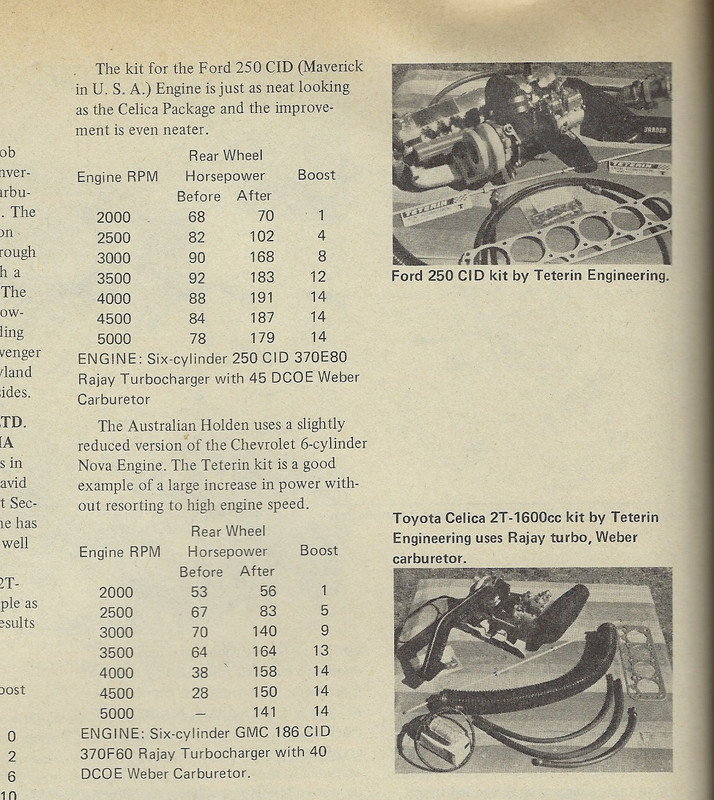If you look at the angle of the Log Heads Exhaust Manifold Flange a spacer would move the Header more down than outwards towards the Shock Tower.A spacer between the headers and the head? Its already close to the shock tower, that might hit but I'll check out his post. If I go turbo though thats not a problem lol.
Yeah I was thinking the 200 might be slightly less to build. Especially now if I'm looking at getting new rods for it
You are using an out of date browser. It may not display this or other websites correctly.
You should upgrade or use an alternative browser.
You should upgrade or use an alternative browser.
All Small Six To Build a 200 or 250?
- Thread starter StarDiero75
- Start date
This relates to all small sixes
... following the wide variety 'bread-boarding' of this 200 vs 250 and Blow-thru vs Draw-Thru builds, pics' are worth .001's
Adapted to the inline six in the pics is late 70's to early 80's Buick/Olds/Pontiac V6/V8 draw-through carb'd setup . The specially ported for turbo Quadrajet is on the 79 Buick manifold to the Garrett TBO3 turbo. I adapted the some of the Buick V6's exhaust. If I swap in a small block 200 it is @1-3/4" shorter than the stroked 250 height and may gain RPM/boost capabilities .
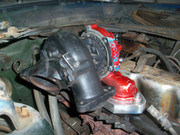 .
. 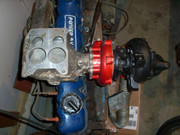 .
.  .
. 
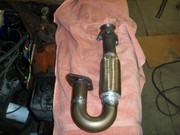 .
. .
. .
. 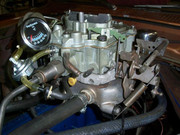 .
.
 .
. 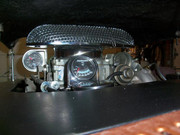 .
.
'Draw Thru - carb'd Turbo setup was the dominant variety until Fuel Injection made everything much simpler. Draw thru has a few peculiarities from Blow-thru:
Draw thru always has fuel at atmosphere pressure so no carb boost-referencing or fuel return needed . Forced induction blow thru will probably require significantly smaller carb spec than NA of same engine, Draw thru requires ridiculous NA cruise to high boost CFM change. Specific OEM Quadrajet for small Buick V6 has external PV port and is spec'd at @850 CFM at high boost !. Draw-thru creates serious venturi chilling at intake usually requiring intake heating provision.
MacInnes makes no statement as to which method is best in "TURBOCHARGERS" . The problem with early draw -thru setups wasn't lack of performance as much as a warranty nightmare for the mfg. . With only enthusiast/light use of a homebrew draw-thru carbd' setup, there is not a real issue with MTBF for the setup.
.. started with getting engine running well NA, next added turbo and significant ignition timing mods. slowly increased boost and carb tuning for safer AFR's until boosting too optomistic at over 1 bar.. ... .
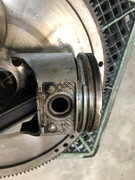 .
. 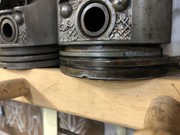
With a SCR of @ 9:1, the 'Effective Compression Ratio Chart" lists the effective CR at 20lbs boost at @ 21:1. Possible a mild built small block six can handle modest boost with a few simple mods , unless you really need to build for the most it can deliver ..
My Maverick now has a Blow-Thru Vortech SC setup and my BOP' Draw-Thru setup is moving to a (forged-piston) second attempt, just deciding on another 250 or the 200 , probably the 200 ? ... ! ...

have fun
Adapted to the inline six in the pics is late 70's to early 80's Buick/Olds/Pontiac V6/V8 draw-through carb'd setup . The specially ported for turbo Quadrajet is on the 79 Buick manifold to the Garrett TBO3 turbo. I adapted the some of the Buick V6's exhaust. If I swap in a small block 200 it is @1-3/4" shorter than the stroked 250 height and may gain RPM/boost capabilities .
 .
.  .
.  .
. 
 .
. .
. .
.  .
. .
.  .
.'Draw Thru - carb'd Turbo setup was the dominant variety until Fuel Injection made everything much simpler. Draw thru has a few peculiarities from Blow-thru:
Draw thru always has fuel at atmosphere pressure so no carb boost-referencing or fuel return needed . Forced induction blow thru will probably require significantly smaller carb spec than NA of same engine, Draw thru requires ridiculous NA cruise to high boost CFM change. Specific OEM Quadrajet for small Buick V6 has external PV port and is spec'd at @850 CFM at high boost !. Draw-thru creates serious venturi chilling at intake usually requiring intake heating provision.
MacInnes makes no statement as to which method is best in "TURBOCHARGERS" . The problem with early draw -thru setups wasn't lack of performance as much as a warranty nightmare for the mfg. . With only enthusiast/light use of a homebrew draw-thru carbd' setup, there is not a real issue with MTBF for the setup.
.. started with getting engine running well NA, next added turbo and significant ignition timing mods. slowly increased boost and carb tuning for safer AFR's until boosting too optomistic at over 1 bar.. ... .
 .
. 
With a SCR of @ 9:1, the 'Effective Compression Ratio Chart" lists the effective CR at 20lbs boost at @ 21:1. Possible a mild built small block six can handle modest boost with a few simple mods , unless you really need to build for the most it can deliver ..
My Maverick now has a Blow-Thru Vortech SC setup and my BOP' Draw-Thru setup is moving to a (forged-piston) second attempt, just deciding on another 250 or the 200 , probably the 200 ? ... ! ...

have fun
Custom pistons are set up for press fit or floating with your choice of wrist pin locks.Thats what I figured. Now would that be press fit or floating? I looked up a set of H beam forged 300 rods for like $615 made for boost applications. They seem very nice.
The 200 six would use the Molar Toyota 1JZ rods with custom pistons.
1JZ Connecting Rods | Molnar H Beam 1JZ Turbo Rods
The 200 would work better with 3.55 to 3.73 gears only because of having to work the clutch to get it rolling otherwise a turbocharger likes to work with the taller gears to build boost. You could probably live with the 3.25 gears with the 200.I'm very divided on the choice of engine here. Torque is great especially throughout the whole range, but RPM sounds fricken great. I want this tame enough to be able to drive it casually too. Current rear gears are 3.25 posi as well if that matters. The 3.25 gears makes me think the 250 might be the better choice, right?
The 250 would be good with 3.25 gears.
The cam profile for either engine with a tube exhaust system is a single pattern with a .050" duration around 230 degrees on a 114 degree LSA.
The 250 can use a hydraulic lifter cam but the higher revving 200 would have better valve train stability with a solid lifter cam.
That also means the valves springs will have to be stiffer for the 200.
At 14lbs of boost you are looking at just over 400 hp.
You would need a turbocharger with a 61mm compressor inducer.
The problem is the Sniper 2300 only has two 100 lb injectors and is only good for 325 hp under boost.
The Super Sniper 2300 has four 100 lb injectors and will handle up to 650 hp under boost.
The Super also will work with 21 lbs of boost which would put you closer to 500 hp
Last edited:
I know at this point blow through is the way to go. I really like to think I want to keep the 200 for this solely b/c i am worried about hood clearance now. I can't flip my drag link b/c i upgraded the steering to 65 V8 steering, I have a 3 core champion alum radiator, I'll have to get all new clutch assembly to the T5. Theres a lot of extra money needing to be spent just for a little more torque and probably same horsepower. Plus, who doesn't love the sound of an inline doing 6500 rpm?! Haha.... following the wide variety 'bread-boarding' of this 200 vs 250 and Blow-thru vs Draw-Thru builds, pics' are worth .001's
Adapted to the inline six in the pics is late 70's to early 80's Buick/Olds/Pontiac V6/V8 draw-through carb'd setup . The specially ported for turbo Quadrajet is on the 79 Buick manifold to the Garrett TBO3 turbo. I adapted the some of the Buick V6's exhaust. If I swap in a small block 200 it is @1-3/4" shorter than the stroked 250 height and may gain RPM/boost capabilities .
.
.
.
.
.
.
.
.
.
'Draw Thru - carb'd Turbo setup was the dominant variety until Fuel Injection made everything much simpler. Draw thru has a few peculiarities from Blow-thru:
Draw thru always has fuel at atmosphere pressure so no carb boost-referencing or fuel return needed . Forced induction blow thru will probably require significantly smaller carb spec than NA of same engine, Draw thru requires ridiculous NA cruise to high boost CFM change. Specific OEM Quadrajet for small Buick V6 has external PV port and is spec'd at @850 CFM at high boost !. Draw-thru creates serious venturi chilling at intake usually requiring intake heating provision.
MacInnes makes no statement as to which method is best in "TURBOCHARGERS" . The problem with early draw -thru setups wasn't lack of performance as much as a warranty nightmare for the mfg. . With only enthusiast/light use of a homebrew draw-thru carbd' setup, there is not a real issue with MTBF for the setup.
.. started with getting engine running well NA, next added turbo and significant ignition timing mods. slowly increased boost and carb tuning for safer AFR's until boosting too optomistic at over 1 bar.. ... .
.
With a SCR of @ 9:1, the 'Effective Compression Ratio Chart" lists the effective CR at 20lbs boost at @ 21:1. Possible a mild built small block six can handle modest boost with a few simple mods , unless you really need to build for the most it can deliver ..
My Maverick now has a Blow-Thru Vortech SC setup and my BOP' Draw-Thru setup is moving to a (forged-piston) second attempt, just deciding on another 250 or the 200 , probably the 200 ? ... ! ...
have fun
Howerver the problem I see is placing the turbo in a decent spot. It looks like she's gonna have to be remote mounted for this to work. Kinda like yours except I'm going to retain the dual out VI headers to maintain breathability
Ok so as long as I spec it all the same its fine. Does it matter performance or reliablilty wise for either?Custom pistons are set up for press fit or floating with your choice of wrist pin locks.
The 200 six would use the Molar Toyota 1JZ rods with custom pistons.
1JZ Connecting Rods | Molnar H Beam 1JZ Turbo Rods
Ok, i see that. This gonna get expensive fast hahaha.
Yeah thats the thing i really kinda regret when I swapped rear gears was picking the 3.25. But they're gonna have to stay for awhile. Plus that might help from busting axles lol.The 200 would work better with 3.55 to 3.73 gears only because of having to work the clutch to get it rolling otherwise a turbocharger likes to work with the taller gears to build boost. You could probably live with the 3.25 gears with the 200.
The 250 would be good with 3.25 gears.
The cam profile for either engine with a tube exhaust system is a single pattern with a .050" duration around 230 degrees on a 114 degree LSA.
The 250 can use a hydraulic lifter cam but the higher revving 200 would have better valve train stability with a solid lifter cam.
That also means the valves springs will have to be stiffer for the 200.
At 14lbs of boost you are looking at just over 400 hp.
You would need a turbocharger with a 61mm compressor inducer.
The problem is the Sniper 2300 only has two 100 lb injectors and is only good for 325 hp under boost.
The Super Sniper 2300 has four 100 lb injectors and will handle up to 650 hp under boost.
The Super also will work with 21 lbs of boost which would put you closer to 500 hp
I'll give schneider a call and see what they think as well. I was also thinking the 200 might need a solid lifter at that point. How would that work with the yella terra rollers? With rollers you don't typically have a gap, right?
Holy smokes!! 400 hp on 14lbs?!?! How did yoy figure that? Is that for the 200 or 250? Or both? So you say a 61mm inducer, do i size the turbo based on AR size or inducer? I always thought it was AR based.
Yup i am aware of that. So there's no going back since i already have the sniper. Its still in the box but there's no returning it, its been way too long. I guess i kkow what hp I'm shooting for now lol. If I get hungry for more, I'll swap to the super sniper when the time comes. But i feel like 325hp in a Ranchero will feel like a lot lol. So boost wise, thats probably in the 8-10 psi range?
So i think I'm gonna roll with the 200. Based on the cost this is looking like its gonna be, I'd prefer not to change other ancillary stuff around the motor as well. The tranny is the weakest link in the drive train and I'll worry about that after she pops lol. I'll just get a built t5 at that point.
Yella Terra roller rockers come in adjustable and non-adjustable models.How would that work with the yella terra rollers? With rollers you don't typically have a gap, right?
The adjustable will work with hydraulic or solid lifer cams.
The hydraulic lifter is preloaded and the rocker arm will have zero gap.
The solid lifters come with a specified gap that you will need to adjust the rocker arms to.
A 61 mm turbo would be the largest, 60 mm being closer to ideal, and you could go as small as 57mm to focus more on low end boost.Holy smokes!! 400 hp on 14lbs?!?! How did yoy figure that? Is that for the 200 or 250? Or both? So you say a 61mm inducer, do i size the turbo based on AR size or inducer? I always thought it was AR based.
A/R stands for Area over Radius. It is defined as the inlet (or, for compressor housings, the discharge) cross-sectional area divided by the radius from the turbo centerline. It does not define turbocharger size.
Turbocharger size is related to the compressor inlet or inducer size which determines how much air the compressor can flow.
Concerning 400 hp, I figured the little 200 six should have at least a 90% volumetric efficiency at 6000 rpm with the cam I specified using the 2V head. Then add an intercooler with a 60% efficiency and 14 lbs of boost.
The power looks like this:
Feel free to play with boost values as well as other values and have fun.
You can also select different size turbochargers to see where the working range falls on the compressor map.
I selected the 61mm turbocharger for reference.
It will answer a lot of questions you may have.
Last edited:
Starr, take the time to get and study, A. Bell's forced induction performance tuning book, it is very good. It is better than the other two guy's books.
I shall return after checking out Pmullers turbo sizing site and doing some research into turbos.
If you have any questions, don’t hesitate to ask.I shall return after checking out Pmullers turbo sizing site and doing some research into turbos.
Old carb draw throughs are normally T3 with a .48 a/r cold side and a .60 a/r hot side is all you need. I stated it the wrong way around, so you can understand what to look for.
You see it's information as European Decimals, Zero Point 48 or Zero Point 60, just like the slang term for 30 thou over being 0.030 inches.
High Temperature Exhaust side is the Turbine A/R = 0.60
Cold Side is the Compressor A/R = 0.48
The specifics for each A/R side, in terms of Inducer and Exducer, are much more complicated.
You see it's information as European Decimals, Zero Point 48 or Zero Point 60, just like the slang term for 30 thou over being 0.030 inches.
High Temperature Exhaust side is the Turbine A/R = 0.60
Cold Side is the Compressor A/R = 0.48
The specifics for each A/R side, in terms of Inducer and Exducer, are much more complicated.
Howdy Guys,
So I've been reading my buddys Street Turbocharging book by Mark Warner and was able to put together an excel sheet. Its a little more rigid than the site Pmuller sent me to but I feel like this gives me a good picture of what I'm looking at. I made a lot of my assumptions fairly conservative so let me know if its too conservative. I feel like this looks fairly accurate power, maybe a little on the low side. However I am pushing the limits of the injectors which worries me. I'm stuck with the sniper and I really don't want to have to buy the super sniper quite yet. Also now that I have some required mass flow rates and a pressure ratio, what is the best route to picking a turbo with a compressor map thats in the ball park as opposed to just picking random turbos and looking, or is that the game?
Also I have it so you all can comment on the excel sheet. So i can make changes as necessary.
200 Turbo Excel Sheet
So I've been reading my buddys Street Turbocharging book by Mark Warner and was able to put together an excel sheet. Its a little more rigid than the site Pmuller sent me to but I feel like this gives me a good picture of what I'm looking at. I made a lot of my assumptions fairly conservative so let me know if its too conservative. I feel like this looks fairly accurate power, maybe a little on the low side. However I am pushing the limits of the injectors which worries me. I'm stuck with the sniper and I really don't want to have to buy the super sniper quite yet. Also now that I have some required mass flow rates and a pressure ratio, what is the best route to picking a turbo with a compressor map thats in the ball park as opposed to just picking random turbos and looking, or is that the game?
Also I have it so you all can comment on the excel sheet. So i can make changes as necessary.
200 Turbo Excel Sheet
Being conservative in this case will get you in trouble.
If the engine makes more power than you are estimating, the injectors will hit their limit, the A/F ratio will go lean, and the engine gets damaged.
The Excel sheet power calculations are off.
A straight six pump gas engine makes no less than 9.5 hp for every lb/min of air. Count on it!
The VE numbers follow the torque curve numbers.
If you select a cam profile for max engine power at 6000 rpm, the torque peak will between 4000 and 4500 rpm.
A 200 with a 250 2V head should have a 95% VE in the 4000 to 4500 rpm range and will drop off gradually on both sides.
A/F ratio is 11.5 under boost.
The purpose of these calculations is to have the range of airflow by weight so you can compare turbocharger compressor maps to see which compressor matches the airflow range.
Let's say you are expecting a power band from 3000 to 6000 rpm using 12 lbs of boost.
That's a range from around 20 to 38 lbs/min. at a pressure ratio of 1.8
Now you can look at a Garrett or Borg Warner catalog to see which compressor map will center those airflow points at the 1.8 pressure ratio line.
That will tell you what turbocharger compressor size to look for.
If the engine makes more power than you are estimating, the injectors will hit their limit, the A/F ratio will go lean, and the engine gets damaged.
The Excel sheet power calculations are off.
A straight six pump gas engine makes no less than 9.5 hp for every lb/min of air. Count on it!
The VE numbers follow the torque curve numbers.
If you select a cam profile for max engine power at 6000 rpm, the torque peak will between 4000 and 4500 rpm.
A 200 with a 250 2V head should have a 95% VE in the 4000 to 4500 rpm range and will drop off gradually on both sides.
A/F ratio is 11.5 under boost.
The purpose of these calculations is to have the range of airflow by weight so you can compare turbocharger compressor maps to see which compressor matches the airflow range.
Let's say you are expecting a power band from 3000 to 6000 rpm using 12 lbs of boost.
That's a range from around 20 to 38 lbs/min. at a pressure ratio of 1.8
Now you can look at a Garrett or Borg Warner catalog to see which compressor map will center those airflow points at the 1.8 pressure ratio line.
That will tell you what turbocharger compressor size to look for.
Last edited:
Get to know your engine performance history using this forum so you know what seems close to right or not.
Use the tech center for small block sixes.
If you look at "The Dyno Room" section, you will see two turbocharged 250s.
One made 423 HP @ 4500 rpm at the rear wheels with the aluminum head on 16 lbs of boost.
The other made 445 hp @ 4300 HP at the rear wheels using a modified log head with 18 lbs of boost.
The actual engine flywheel power will be more.
The 250 2V head puts you in between those two for performance potential.
Use the tech center for small block sixes.
If you look at "The Dyno Room" section, you will see two turbocharged 250s.
One made 423 HP @ 4500 rpm at the rear wheels with the aluminum head on 16 lbs of boost.
The other made 445 hp @ 4300 HP at the rear wheels using a modified log head with 18 lbs of boost.
The actual engine flywheel power will be more.
The 250 2V head puts you in between those two for performance potential.
So it looks like I'm gonna be able to run no more than 5psi of boost then with the basic 2300.... So here's a question, is there a benefit to running the 4150 super sniper? It'll support 650 hp or should I go with the 2300 super sniper then? If I go with the 4150, is there any benefit or drivability concerns if I get the large plenum Aussie Speed 4bbl intake? B/c i think running a 2-4 adapter is just stupid if I'm dumping the money everywhere else lol. I think the aussie speed intake will also improve efficiency here.
New power number after revisions is 490hp on 14psi at the crank. And thats probably low assuming using the aussie speed intake Here's the new sheet. 200 Turbo Excel
New power number after revisions is 490hp on 14psi at the crank. And thats probably low assuming using the aussie speed intake Here's the new sheet. 200 Turbo Excel
Aussiespeed 4 barrel Ford six 250 2V Performance Manifold AS0011 | Aussiespeed Street & Racing Products Australia
ford performance 2v 250 4 barrel intake manifold is low profile for bonnet clearance in early ford and cortina 4150 and 4160 holley vac and double pumper
www.aussiespeedshop.com
Last edited:
The Super Sniper 2300 flows 580 cfm which is more than enough for a 200 six. The 4150 flows 800 cfm.
The 4150 will make full power around half throttle, making throttle response very touchy.
You won't like the lack of small throttle control.
The 4150 will make full power around half throttle, making throttle response very touchy.
You won't like the lack of small throttle control.
Last edited:
Jmustang_65
Well-known member
I would stick with your 2300 and run 12-15 lbs of boost. If the injectors go lean you can always upgrade them. You will be around the 430-450hp mark.So it looks like I'm gonna be able to run no more than 5psi of boost then with the basic 2300.... So here's a question, is there a benefit to running the 4150 super sniper? It'll support 650 hp or should I go with the 2300 super sniper then? If I go with the 4150, is there any benefit or drivability concerns if I get the large plenum Aussie Speed 4bbl intake? B/c i think running a 2-4 adapter is just stupid if I'm dumping the money everywhere else lol. I think the aussie speed intake will also improve efficiency here.
New power number after revisions is 490hp on 14psi at the crank. And thats probably low assuming using the aussie speed intake Here's the new sheet. 200 Turbo Excel
Aussiespeed 4 barrel Ford six 250 2V Performance Manifold AS0011 | Aussiespeed Street & Racing Products Australia
ford performance 2v 250 4 barrel intake manifold is low profile for bonnet clearance in early ford and cortina 4150 and 4160 holley vac and double pumperwww.aussiespeedshop.com
Ok I just want to make sure I don't end up buying something else that will hold me back. So do you think the aussie manifold is worth getting or just keep the factory manifold? Either way I have to have an adapter for a Rochester/Stromberg-Holley or 4bbl to 2bbl to run the 2300 on either manifold.The Super Sniper 2300 flows 580 cfm which is more than enough for a 200 six. The 4150 flows 800 cfm.
The 4150 will make full power around half throttle, making throttle response very touchy.
You won't like the lack of small throttle control.
I'll check out the dyno stuff on the 250 in a bit.
Also, after some other reading, it appears using actual NA headers is not a good choice at all for exhaust. From what I was reading in the Warner Turbo book is that the custom log manifold I have may actually be better to run. Yes it does have a lot of back pressure but exhaust scavenging is not as important in the low to mid boost world. The back pressure results in a quicker spool.
Similar threads
All Small Six
200 and 250 fuel pumps not quite the same?
- Replies
- 4
- Views
- 214
All Small Six
Timing Help
- Replies
- 4
- Views
- 1K
All Small Six
Early 60s 200 in a Falcon with a 144
- Replies
- 9
- Views
- 517
All Small Six
Starting new build
- Replies
- 114
- Views
- 8K
- Replies
- 7
- Views
- 1K

